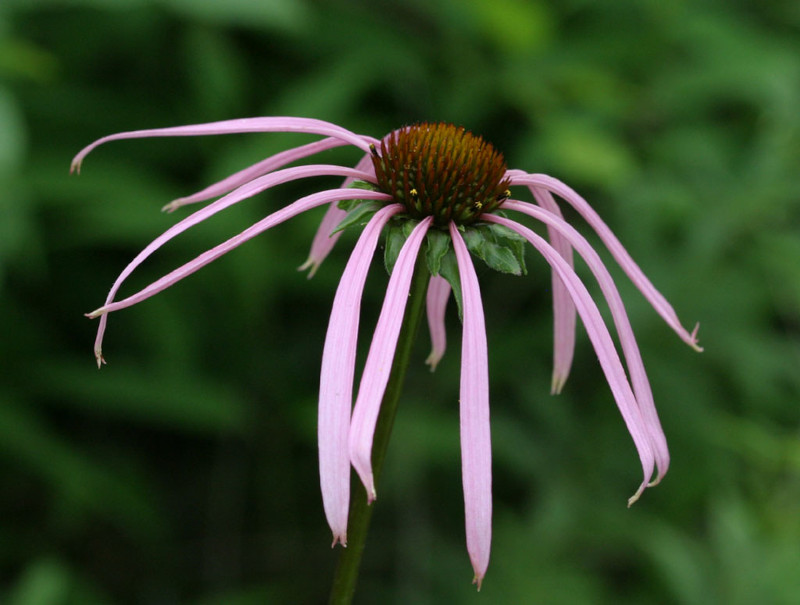Smooth Purple Coneflower Facts
- The most often used name for this marvel of Nature and evolution is that of the descriptive term of the Smooth Purple Coneflower. Surprisingly, though, for the moment, this unique variety of flora has no other generally accepted common name.
- Among professionals, however, it’s more often referred to by its scientific name. That term, as such names often do, remains somewhat difficult for the non-professional to pronounce. That’s because it bears the technical name of Echinacea laevigata.
- It’s also worth noting that botanists did not even identify the Angiosperm until 1929. At that time, a two-man team of researchers accomplished the first formal recognition of it as a separate species. The men were Charles Boynton and Chauney Beadle.
- Regrettably, the wildflower does not appear to have ever had a particularly broad zone of habitation. Not surprisingly, though, that’s now been even further reduced, largely through the actions of man. That’s mainly due to our explosive expansion.
- Sadly, this reduction in its territorial range also reduces its overall population. Due to this, the IUCN presently lists the marvelous plant as Near-Threatened. That status appears reflected on the organization’s published Red List of Threatened Species.
- The Smooth Purple Coneflower faces multiple threats to its continued existence as a species. Direct human expansion into, and resulting destruction of, its native territory isn’t the only danger it faces, though. Climate change now endangers it as well.
Related Articles
Smooth Purple Coneflower Physical Description
The intriguing Smooth Purple Coneflower impresses those who encounter it for a variety of reasons. Though sheer size, therefore, isn’t the only factor in that condition, it certainly ranks among them. This holds true since the plant attains some respectable measurements.
It further resembles its close relative, the common echinacea, in this trait. This particular species attains a stem height of as much as 5 ft (1.5 m)! That same stem typically develops as quite thin, and strongly vertical in nature. It’s also mainly devoid of any foliage.
Scattered leaves do appear, however, in some instances. When these do make an appearance, though, they appear at random intervals on the smooth stem. Each of these structures further develops with a highly elongated, lance-shaped structure, and a dark green shade.
While the smoothness of the stem serves as part of the common name, it’s the unique flowers of the plant that form the rest. The perennial herb produces a single bloom atop each of the high-rising stems. This sometimes shows pink, but usually purple.
Meanwhile, the flower itself holds a fascinating structure of its own. It produces numerous, narrow florets, boasting the base colors. These also average about 3.2 in (8 cm) in length. In a remarkable design, these droop away from the head of the amazingly evolved flower.
The center of the Smooth Purple Coneflower holds yet another surprise for those who discover it. That’s because this section of the plant typically shows dark purple. The fruit the tantalizing flora produces additionally reaches roughly 0.2 in (0.5 cm) in total length.
- Kingdom: Plantae
- Phylum: Angiosperms
- Class: Eudicots
- Order: Asterales
- Family: Asteraceae
- Genus: Echinacea
- Species: E. laevigata
Smooth Purple Coneflower Distribution, Habitat, and Ecology
Sadly, both for the fabulous Smooth Purple Coneflower itself, and for those who appreciate Nature, the plant evolved as native to a very limited portion of the globe. That’s due to the fact that it appears endemically in only a small part of the continent of North America.
Originally, it appeared in only six states, in the Piedmont region of the United States. Unfortunately, it no longer appears in the states of Maryland and Pennsylvania. It therefore now only lives natively in Virginia, Georgia, South Carolina, and North Carolina.
This marvel of Nature seems deceptively delicate, at least at first glance, but actually isn’t. It further developed to survive, and even thrive, in a very specific combination of conditions. Many, if not most, plants, however, generally find one of those conditions inimical.
The Angiosperm mainly appears in well-lit open areas, within a forested region. That preference it shares with many flora, though. Yet, it also requires soil rich in magnesium and calcium. It also prefers the presence of limestone, and minerals of volcanic origin.
The uniquely-evolved Smooth Purple Coneflower also typically blooms from May to June, in its native region. It achieves pollination of those blooms via the actions of numerous local insect species. These include honeybees, bumblebees, and various local butterflies.
Though not fully certain, researchers believe its seeds are spread by birds, after consuming the fruit. In some observed instances, though, it also reproduces asexually. This it accomplishes by producing new plants from shoots from existing stems or rhizomes.
Species Sharing Its Range
Check out our other articles on 7 North American Desert Dwellers, Yellow-Bellied Sea Snake, Mount Kinabalu, Wilson’s Bird-of-paradise, Hibiscus Harlequin Bug, Honey Badger, Serval

